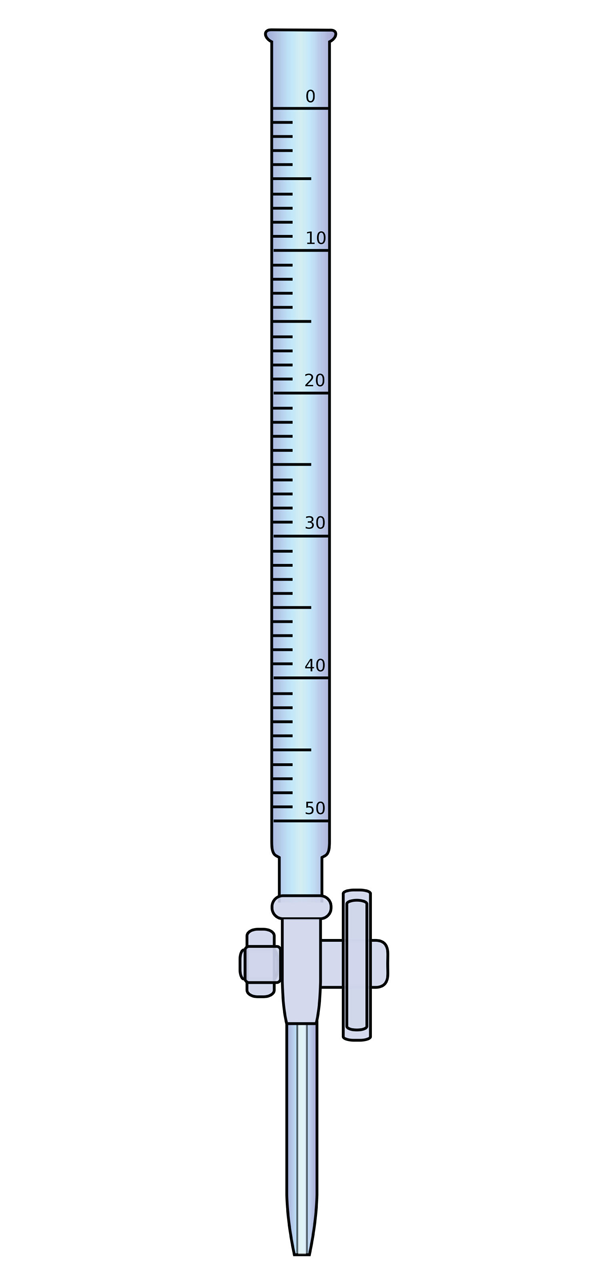6.5 Acid-Base Titrations
Learning Objectives
- Describe a titration experiment.
- Explain what an indicator does.
- Perform a titration calculation correctly.
The reaction of an acid with a base to make a salt and water is a common reaction in the laboratory, partly because so many compounds can act as acids or bases. Another reason that acid-base reactions are so prevalent is that they are often used to determine quantitative amounts of acid or the base used for the experiment. Performing chemical reactions quantitatively to determine the exact amount of a reagent is called a titration. A titration can be performed with almost any chemical reaction for which the balanced chemical equation is known. Here, we will consider titrations that involve acid-base reactions.
In a titration, one reagent has a known concentration or amount, while the other reagent has an unknown concentration or amount. Typically, the known reagent (the titrant) is added to the unknown quantity and is dissolved in solution. The unknown amount of substance (the analyte) may or may not be dissolved in the solution (But usually it is). The titrant is added to the analyte using a precisely calibrated volumetric delivery tube called a burette (Figure 6.5.1 "Equipment for Titrations"). The burette has markings to determine how much volume of solution has been added to the analyte. When the reaction is complete, it is said to be at the equivalence point; the number of moles of titrant can be calculated from the concentration and the volume, and the balanced chemical equation can be used to determine the number of moles (and then concentration or mass) of the unknown reactant.

For example, suppose [latex]{25.66 mL}[/latex] (or [latex]{0.02566 L}[/latex]) of [latex]{0.1078 M}[/latex] [latex]\ce{HCl}[/latex] was used to titrate an unknown sample of [latex]\ce{NaOH}[/latex]. What mass of [latex]\ce{NaOH}[/latex] was in the sample?
We can calculate the number of moles of [latex]\ce{HCl}[/latex] reacted:
[latex]\#\text{ mol HCl}=(0.02566\text{ L})(0.1078\text{ M})=0.002766\text{ mol HCl}[/latex]
We know the balanced chemical reaction between HCl and NaOH:
[latex]\ce{HCl} + \ce{NaOH} → \ce{NaCl} + \ce{H_{2}O}[/latex]
So, we can construct a conversion factor to convert to the number of moles of [latex]\ce{NaOH}[/latex] reacted:

Then we convert this amount to mass, using the molar mass of [latex]\ce{NaOH}[/latex] (40.00 g/mol):

This type of calculation is performed as part of a titration.
Example 6.5.1
Problem
What mass of [latex]\ce{Ca(OH)_{2}}[/latex] is present in a sample if it is titrated to its equivalence point with [latex]{44.02 mL}[/latex] of [latex]{0.0885 M}[/latex] [latex]\ce{HNO_{3}}[/latex]? The balanced chemical equation is as follows:
[latex]\ce{2HNO_{3}} + \ce{Ca(OH)_{2}} → \ce{Ca(NO_{3})_{2}} + \ce{2H_{2}O}[/latex]
Solution
In litres, the volume is [latex]{0.04402 L}[/latex]. We calculate the number of moles of titrant:
[latex]\#\text{ moles }\ce{HNO3}=(0.04402\text{ L})(0.0885\text{ M})=0.00390\text{ mol }\ce{HNO3}[/latex]
Using the balanced chemical equation, we can determine the number of moles of [latex]\ce{Ca(OH)_{2}}[/latex] present in the analyte:
[latex]0.00390\cancel{\text{ mol }\ce{HNO3}}\times\dfrac{1\text{ mol }\ce{Ca(OH)2}}{2\cancel{\text{ mol }\ce{HNO3}}}=0.00195\text{ mol }\ce{Ca(OH)2}[/latex]
Then we convert this to a mass using the molar mass of [latex]\ce{Ca(OH)_{2}}[/latex]:
[latex]0.00195\cancel{\text{ mol }\ce{Ca(OH)2}}\times \dfrac{74.1\text{ g }\ce{Ca(OH)2}}{1\cancel{\text{ mol }\ce{Ca(OH)2}}}=0.144\text{ g }\ce{Ca(OH)2}[/latex]
Test Yourself
What mass of [latex]\ce{H_{2}C_{2}O_{4}}[/latex] is present in a sample if it is titrated to its equivalence point with [latex]{18.09 mL}[/latex] of [latex]{0.2235 M}[/latex] [latex]\ce{NaOH}[/latex]? The balanced chemical reaction is as follows:
[latex]\ce{H_{2}C_{2}O_{4}} + \ce{2NaOH} → \ce{Na_{2}C_{2}O_{4}} + \ce{2H_{2}O}[/latex]
Answer
0.182 g
How does one know if a reaction is at its equivalence point? Usually, the person performing the titration adds a small amount of an indicator, a substance that changes colour depending on the acidity or basicity of the solution. Because different indicators change colours at different levels of acidity, choosing the correct one is important in performing an accurate titration.
Key Takeaways
- A titration is the quantitative reaction of an acid and a base.
- Indicators are used to show that all the analyte has reacted with the titrant.
Exercises
In chemistry, a reagent is a substance or compound that is added to a system to cause a chemical reaction or to detect the presence of a specific substance. Reagents are used in laboratories and industrial settings for various purposes, such as synthesising new compounds, analysing substances, or carrying out chemical transformations.

